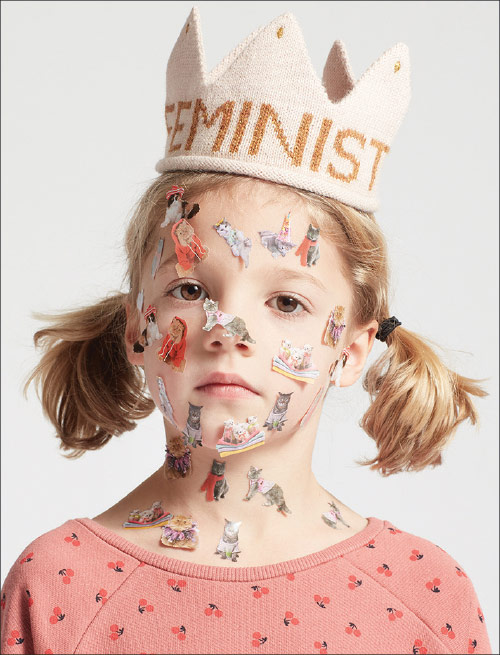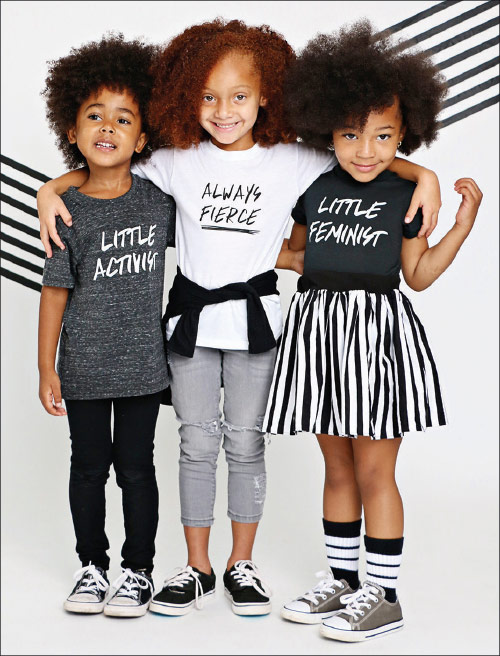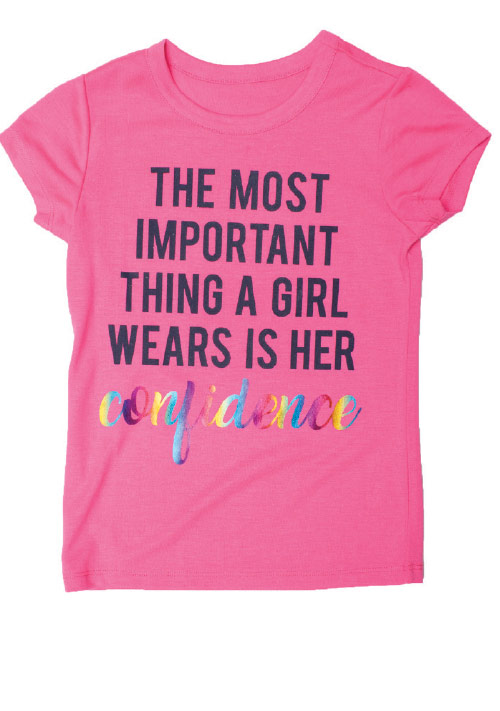Designers are giving small voices a big platform with female empowerment messaging.

Oeuf knit crown
Childhood innocence? Ignorance is bliss? Not so much in an age where terrorism, school shootings and the #MeToo movement include young victims and millions more dialed in on social media demanding change. Kids today have had it! New movements like #MeNext (to enact gun control), nationwide school walkouts, planned marches on Washington, sit downs with President Trump, slogans, rallying cries, posters, messaging on clothing—whatever it takes to make their voices heard. Girls, especially, have taken to wearing their protests on their tees, dresses, hats, totes, etc.
“There’s so much frustration, and people are expressing it in so many different ways: marches, speeches, conversations and inevitably in clothing as well,” says Sophie Demenge, founder of Oeuf. “The Women’s March and International Women’s Day really galvanized a movement, and what women are wearing is just one of the many forms of expression involved.”
Some experts point to Paris Fashion Week in September 2016, when Maria Grazia Chiuri, Christian Dior’s first-ever female creative director, sent models down the runway in “We Should All Be Feminists” tees for igniting the feminist-themed frocks movement. They immediately sold out and went into reproduction. The following year, Chiuri debuted “Why Have There Been No Great Women Artists?” horizontal-striped shirts. Designers Prabal Gurung, Christian Siriano and Public School have since released activist-themed fashions, which included shirts with phrases, “People are People” and “The Future is Female.” Childrenswear designers have also followed suit, featuring an array of female empowerment graphics and verbiage in their latest collections. The message even extends to promoting STEM education and confidence-boosting, especially for little girls. In early 2017, Tressy Club led the way with its “Girl Gang” slogans, while social media influencer Vada of Miasaidno rocked a “The Future is Female” shirt. Inspired by women who knitted their own “pussy” hats for #MeToo marches, Demenge created a knit crown for Oeuf with “Feminist” written across it. Released for 2017 International Women’s Day in dark gray and pink, it was the first time the label’s crowns came in adult sizes as well. “The crown provided a fun way for mothers to explore these ideas with their daughters and sons—and fathers, too!” she says. “We received pictures of entire families wearing the crowns, which was fantastic.” Oeuf has since partnered with Reformation to create a one-piece with the same message.

Love Bubby tees
Jaime Windau, owner and designer of Love Bubby, lived up to the company’s tagline “You are never too young to make a statement,” with the release last spring of a shirt with “Little Feminist” written across the front. It accounted for almost 80 percent of the young company’s seasonal profits and was followed up with “Little Activist” and “Always Fierce” tees and one-pieces. Windau has been surprised by buyer reactions to the female empowerment messaging featured on her clothing—some positive and others hesitant. “They’re either really for it or say something like, ‘Her father would kill me for this,’” she says. “It opens a great line of dialogue because, for such a long time, feminism has had an ugly stigma. But look it up in the dictionary—it’s such a positive term,” she adds.
Rashti & Rashti opted for a less potentially polarizing message. In a licensing deal with Beeposh, the manufacturer created a collection of loungewear, sleepwear and soft accessories featuring slogans like “Girl Tribe,” “Soul Sisters” and “The Most Important Thing a Girl Wears is Her Confidence.” The line, designed for ages 4 to 12, is meant to build upon the positive influence of powerful female role models in politics, athletics and fashion that show girls they can accomplish anything, according to Danielle Signorelli, marketing director for Rashti & Rashti. “Young girls look to older sisters and role models, so we’ve given them appropriate and positive messaging for all ages,” she says.
The phrase-centric designs are relatively new in girls’ collections, which have been historically graphic-driven. Lauren Zodel, assistant professor of fashion design in childrenswear at the Fashion Institute of Technology, says it marks a shift as text-heavy clothing is usually found in boys’ apparel. “Designers are relooking at the approach they take to designing boys’ vs. girls’ clothing,” she says. “Given the female empowerment movement momentum, text in their collections can work too.”
Jamara Ghalayini, owner of Pumpkinheads in Los Angeles, is stocking girl power items—as long as they are positive in their messaging and design. “We don’t do well when collections take on the concept that to be strong, bold and fearless, it has to be dark, heavy and without a flirty, fun feel at all,” she says. “Our customers still want apparel that is ‘girls’ and ‘boys.’ We don’t have the demand for gender neutral apparel yet.” Ghalayini adds that there’s a fine line to merchandising these girl power-themed items. “I love embracing cultural and community trends, but I also am very opposed to using children as messaging objects,” she says, adding that she refuses to sell anything political or antagonizing. “The girl power trend isn’t a focal point for us, so I merchandise it within everything else as a little bit of flare for those that catch on.”
Retailers and designers are wise to tread lightly as not everyone is on board with female empowerment, and children might attract unwanted attention by wearing such slogans. Rashti & Rashti aims to meet in the middle. “What we create is not supposed to offend but encourage,” Signorelli says. “It’s something parents can feel good about buying for their girls.”

Beeposh shirt
The other potential drawback of this trend is the message gets watered down and, like with most fashions, comes and goes. “It could definitely lose its true focus and become just an everyday graphic tee with not that much thought put into the purchase,” says Erin Rechner, senior kidswear Editor at WGSN. She suggests donating to or partnering with nonprofits related to the cause as a way to possibly prevent that from happening. “This would be a way to help bring back the true meaning of the message and help people gain confidence and acceptance,” she says.
Ghalayini, on the other hand, believes the further the message of female empowerment spreads, the better. “If the message has meaning and we are truly trying to support and empower girls, why would we prevent this from becoming the most commercialized message out there?” she says. “Why not want it on every billboard, city bus and marketing opportunity possible?”
One thing most industry experts agree on: girl power is here to stay. How it appears in fashion may ebb and flow, but the belief is there is no turning back. The pendulum has shifted: “Wonder Woman” has raked in more than $100 million at the box office—a record for a female-directed movie that also opens up a world of licensing possibilities—the Powerpuff Girls are getting a reboot, the new DC Super Hero Girls action figure franchise continues to grow in popularity and, perhaps most important of all, millions of young girls around the world are waking up to the fact that they have a voice and a right to be treated equally. Such ignorance is no longer bliss!
“This verbiage may not be upfront all the time, but strong girl power has staying power,” Zodel says. Rechner agrees: “Everything from Ashley Graham and the body positive movement impacting little girls around the world, to the inclusion of transgender people in the fashion industry such as Teddy Quinlivan and Leyna Bloom—celebrating differences and women have never been so front-and-center.” •



Leave a Comment: